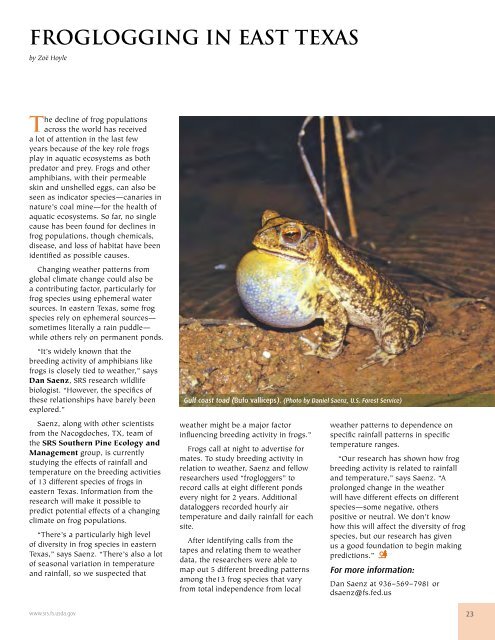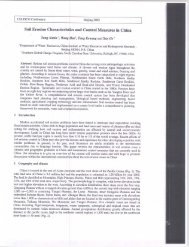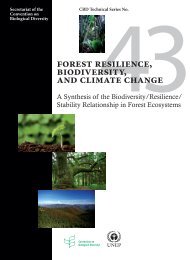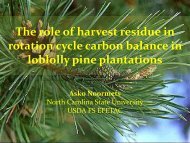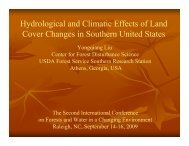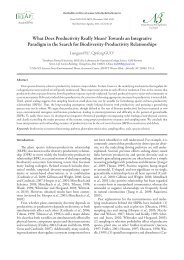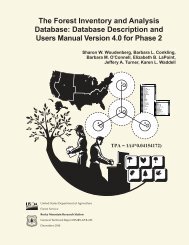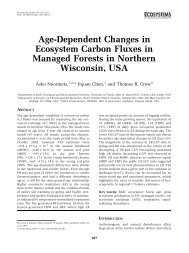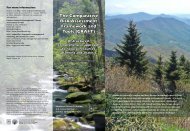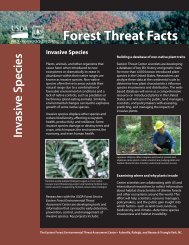What do forests have to do with global climate change? What do ...
What do forests have to do with global climate change? What do ...
What do forests have to do with global climate change? What do ...
You also want an ePaper? Increase the reach of your titles
YUMPU automatically turns print PDFs into web optimized ePapers that Google loves.
Froglogging in East Texas<br />
by Zoë Hoyle<br />
The decline of frog populations<br />
across the world has received<br />
a lot of attention in the last few<br />
years because of the key role frogs<br />
play in aquatic ecosystems as both<br />
preda<strong>to</strong>r and prey. Frogs and other<br />
amphibians, <strong>with</strong> their permeable<br />
skin and unshelled eggs, can also be<br />
seen as indica<strong>to</strong>r species—canaries in<br />
nature’s coal mine—for the health of<br />
aquatic ecosystems. So far, no single<br />
cause has been found for declines in<br />
frog populations, though chemicals,<br />
disease, and loss of habitat <strong>have</strong> been<br />
identified as possible causes.<br />
Changing weather patterns from<br />
<strong>global</strong> <strong>climate</strong> <strong>change</strong> could also be<br />
a contributing fac<strong>to</strong>r, particularly for<br />
frog species using ephemeral water<br />
sources. In eastern Texas, some frog<br />
species rely on ephemeral sources—<br />
sometimes literally a rain puddle—<br />
while others rely on permanent ponds.<br />
“It’s widely known that the<br />
breeding activity of amphibians like<br />
frogs is closely tied <strong>to</strong> weather,” says<br />
Dan Saenz, SRS research wildlife<br />
biologist. “However, the specifics of<br />
these relationships <strong>have</strong> barely been<br />
explored.”<br />
Saenz, along <strong>with</strong> other scientists<br />
from the Nacog<strong>do</strong>ches, TX, team of<br />
the SRS Southern Pine Ecology and<br />
Management group, is currently<br />
studying the effects of rainfall and<br />
temperature on the breeding activities<br />
of 13 different species of frogs in<br />
eastern Texas. Information from the<br />
research will make it possible <strong>to</strong><br />
predict potential effects of a changing<br />
<strong>climate</strong> on frog populations.<br />
“There’s a particularly high level<br />
of diversity in frog species in eastern<br />
Texas,” says Saenz. “There’s also a lot<br />
of seasonal variation in temperature<br />
and rainfall, so we suspected that<br />
Gulf coast <strong>to</strong>ad (Bufo valliceps). (Pho<strong>to</strong> by Daniel Saenz, U.S. Forest Service)<br />
weather might be a major fac<strong>to</strong>r<br />
influencing breeding activity in frogs.”<br />
Frogs call at night <strong>to</strong> advertise for<br />
mates. To study breeding activity in<br />
relation <strong>to</strong> weather, Saenz and fellow<br />
researchers used “frogloggers” <strong>to</strong><br />
record calls at eight different ponds<br />
every night for 2 years. Additional<br />
dataloggers recorded hourly air<br />
temperature and daily rainfall for each<br />
site.<br />
After identifying calls from the<br />
tapes and relating them <strong>to</strong> weather<br />
data, the researchers were able <strong>to</strong><br />
map out 5 different breeding patterns<br />
among the13 frog species that vary<br />
from <strong>to</strong>tal independence from local<br />
weather patterns <strong>to</strong> dependence on<br />
specific rainfall patterns in specific<br />
temperature ranges.<br />
“Our research has shown how frog<br />
breeding activity is related <strong>to</strong> rainfall<br />
and temperature,” says Saenz. “A<br />
prolonged <strong>change</strong> in the weather<br />
will <strong>have</strong> different effects on different<br />
species—some negative, others<br />
positive or neutral. We <strong>do</strong>n’t know<br />
how this will affect the diversity of frog<br />
species, but our research has given<br />
us a good foundation <strong>to</strong> begin making<br />
predictions.”<br />
For more information:<br />
Dan Saenz at 936–569–7981 or<br />
dsaenz@fs.fed.us<br />
www.srs.fs.usda.gov 23


